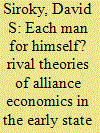| Srl | Item |
| 1 |
ID:
113327


|
|
|
|
|
| Publication |
2012.
|
| Summary/Abstract |
When military alliances are expensive, they naturally raise distributional issues. This article considers two theories to explain how much a state will voluntarily contribute to the economic burdens of defense. Empirical work has relied largely on data from the twentieth century. This article provides an out-of-sample test to evaluate the models. Using data on the Quintuple Alliance, the results are more consistent with the predictions of the joint products model than the pure public goods model. Due to credible commitment problems, and intra-alliance cleavages, I argue that we should not expect substantial free riding in most conventional military alliances.
|
|
|
|
|
|
|
|
|
|
|
|
|
|
|
|
| 2 |
ID:
119784


|
|
|
|
|
| Publication |
2013.
|
| Summary/Abstract |
This paper analyses the incentives to participate in an international climate agreement and the stability of the resulting climate coalition using the integrated assessment model WITCH. Coalition stability is assessed under alternative assumptions concerning the pure rate of time preference, the aggregation of social welfare, and the severity of climate damages. The profitability, stability, and strong potential internal stability of a number of coalitions, those potentially effective in reducing GHG emissions, is explored in the paper. The main conclusion is that only the grand coalition, i.e. a coalition where all world regions cooperate to reduce emissions, can maintain GHG concentration below 550 ppm CO2-eq. However, this coalition is not internally stable, even when allowing for monetary transfers across world regions. Nonetheless, the paper also shows that strongly potentially internally stable coalitions exist, though of smaller size, which can mitigate global warming and limit GHG concentrations to 600 ppm CO2-eq.
|
|
|
|
|
|
|
|
|
|
|
|
|
|
|
|